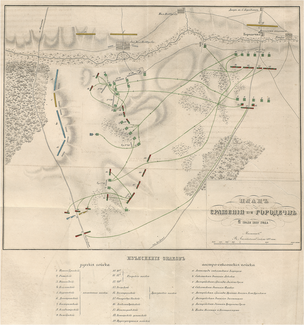Battle of Gorodechno
| Battle of Gorodechno | |||||||
|---|---|---|---|---|---|---|---|
| Part of the French invasion of Russia | |||||||
 Attack of a Dragoon regiment on the French artillery (painting by Nikolay Samokish) | |||||||
| |||||||
| Belligerents | |||||||
|
|
| ||||||
| Commanders and leaders | |||||||
|
|
| ||||||
| Strength | |||||||
| 18,000[1] | 40,000[1] | ||||||
| Casualties and losses | |||||||
| 3,000[1] |
1,300 Austrians[2] 930 Saxons[2] | ||||||

The Battle of Gorodechno took place between an army of the Austrian and Saxon allies of Napoleonic France under the command of the Prince of Schwarzenberg and Russian troops under Alexander Tormasov at Gorodechno, a town in Kobrinsky Uyezd, Grodno Governorate (now Pruzhany District, Brest Region in Belarus). The battle was ultimately won by France's allies when Tormasov was forced to retire.[3][4]
Background[edit]
In July 1812, France's Austrian and Saxon allies were given orders to move into Russia on the right flank of Napoleon's Grande Armée as it drove toward Moscow. The allied force was composed of 30,000 Austrians under the command of Schwarzenberg and 13,000 Saxons under the command of General Jean Reynier. Operating in that area for the Russians was Tormasov leading a force of 40,000 on a mission to move about behind Napoleon's forces disrupting activities and communications. During July, the Russians successfully defended Kobryn and send troops north to Pruzhany and Bialystok spreading panic and concern. Ultimately concerned about the allied pursuit, Tormasov retired and took a defensive position without his reserve forces at Gorodechno.[5]
Battle[edit]
At daybreak on 12 August 1812, the allies attacked utilizing causeways to cross a marsh behind which Tormasov had established his defensive line and battery. Reynier and the Saxon advance guard composed primarily of cavalry had the greatest success against the Russian defenses as they were able to move across the northern causeway relatively unimpeded and initiate a flank movement on the Russian left. Tormasov quickly shifted his forces to form a new line of defense on his left. [3][6]
The battle continued throughout the day and included active exchanges of artillery fire. Tormasov and the Russian defenses on the left held strong and kept the allies from enveloping their position. Concurrently Saxon forces shifted part of their focus and attacked the Russian position in the center supported by artillery. The Russians continued to hold strong and the initial allied effort at a breakthrough in the center failed. Toward evening, a battalion of Austrian Colloredo joined the battle at the center after struggling on foot through the marshes. A fight for the high ground took place with the allies gaining a position only to pushed back later by the Russians. Meanwhile, the fighting on the Russian left flank continued only to end in failure for the allies. At the end of the day, the dead and wounded among both the Russians and the allies numbered in the thousands.[7][8]
Although the Russian defensive position remained intact, that evening Tormasov made the decision to withdraw based upon his belief that the allies would renew the attack in the morning with an additional 21 battalions of fresh troops that had yet to be engaged in the battle.[4]
Aftermath[edit]
Schwarzenberg's victory at Gorodechno along with the victory of French General Saint-Cyr over the Russians on the Grande Armée's left flank at Polotsk on 17-18 August gave Napoleon the confidence to continue with his advance toward Moscow responding to all objections with the comment "The wine has been poured, it must now be drunk."[3]
See also[edit]
Notes[edit]
- ^ a b c d Bodart 1908, p. 435.
- ^ a b Smith 1998, p. 385.
- ^ a b c Riehn 1990, p. 230.
- ^ a b Wilson 1860, p. 71.
- ^ Wilson 1860, pp. 66–68.
- ^ Wilson 1860, pp. 69–70.
- ^ Wilson 1860, pp. 70–71.
- ^ Smith 1998, pp. 385–386.
References[edit]
- Bodart, Gaston (1908). Militär-historisches Kriegs-Lexikon (1618-1905). Wien und Leipzig, C. W. Stern.
- Riehn, Richard K. (1990). 1812 : Napoleon's Russian campaign. ISBN 9780070527317.
- Smith, Digby (1998). The GreenhillNapoleonic Wars Data Book. London: Greenhill Books. ISBN 1-85367-276-9.
- Wilson, Robert Thomas (1860). Narrative of events during the Invasion of Russia by Napoleon Bonaparte, and the Retreat of the French Army, 1812. London: John Murray. Retrieved 17 April 2021.
External links[edit]
- Brockhaus and Efron Encyclopedic Dictionary
- Novitsky, Vasily (1911–1915). Military Encyclopedia of Sytin. Printing house of Ivan Sytin.
 Media related to Battle of Haradziečna at Wikimedia Commons
Media related to Battle of Haradziečna at Wikimedia Commons
| Preceded by Battle of Majadahonda |
Napoleonic Wars Battle of Gorodechno |
Succeeded by Battle of Smolensk (1812) |


